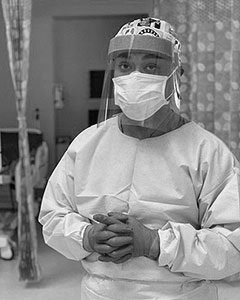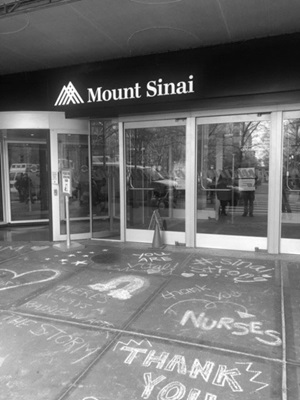In this issue, we talked to Dr. Joseph Herrera at the Icahn School of Medicine at Mount Sinai in New York, NY. During the initial outbreak, Dr. Herrera and his team worked to innovate how patients were receiving medical treatment both in the hospital and at home. The work being done and the data gathered has helped to establish a new post-COVID clinic at Mount Sinai and pave the way for innovative treatments for patients with Post-Acute Sequelae of SARS-CoV-2 (PASC) infection. The following article is based on his experience from mid-September 2020 and Summer 2021.

Joseph Herrera, DO, FAAPMR
Department Chair, PM&R Program
Icahn School of Medicine at Mount Sinai
At Mount Sinai, it was a stressful time. I remember the date that we heard of our first case in New York City: March 2, 2020. The news headline was "first case confirmed in New York City at an undisclosed hospital." At the time, we never imagined the turmoil that we would have to endure and innovate around, in what would become a COVID-19 world.
At first, our leadership team planned to transform our rehab units into post-COVID or COVID-19 units so that we could rehab patients who were recovering from the infection. We did not know what was headed our way. We thought that the patients were going to be admitted to the ICU, recover and need rehab. But as the saying goes, best laid plans often go awry. The reality was New York State issued a stay-at-home order on March 13, 2020 and things started to shut down. Our faculty and residents at Elmhurst Hospital Center shared stories about the PPE shortage and numerous refrigerated trucks parked outside since there was no space left for bodies in the morgue.
Seeing how our residents and faculty struggled at Elmhurst, hearing about all the death and challenges made us adjust our plans. We knew we had three key areas to utilize, transform and mobilize: our clinical operations, our innovative technologies and our volunteers.
1. Clinical Operations: Our clinical operations required three stages for transformation: we needed safe discharge destinations for current rehab patients, we needed to transform the units to take critically ill patients, and we needed to create our medical teams. With regard to safe discharge destinations for our rehab patients, I am grateful for the extraordinary communication among the chairs in the Northeast. My colleagues Matt Bartels, MD, MPH, FAAPMR; Sara Cuccurullo, MD, FAAPMR; Adam Stein, MD, FAAPMR; Joel Stein, MD, FAAPMR; Steve Flanagan, MD, FAAPMR; and Steve Kirshblum, MD, FAAPMR were all fantastic. When we needed a way to get our patients to safety, they were there for us.
Once the patients were safely discharged we began stage two. My staff stayed late to take all the equipment out of the gyms to transform them; we went from 50 beds at the Mount Sinai campus to 90 because the extension of the gym allowed us to accomodate roughly 20 additional beds. We then created separate zones on the unit that were designated by color to indicate PPE requirement for safety. For example, the Red Zone required full PPE, Yellow Zone was mixed PPE and the Green Zone required no PPE at all. The Green Zone was where we ate, did sign-out, etc. The third stage was creating our medical teams. We decided to keep all of the rehab faculty, residents, fellows and nurses together with hospitalist oversight. We initially created teams of two attendings, residents and fellows that would do four-day shifts (12-hours each shift). Then, the patients came.
Little did we know that the easy part was behind us. The hard part truly came with staffing. We had a number of therapists and nurses who decided they weren't going to work at Mount Sinai anymore and a number of attendings who were scared. At the end of the day, we were all scared.
Once we got our teams together and started on the frontlines, we were under the impression that we were going to get the more stable patients since we weren't the "critical care people," in essence. But that wasn't the case. We were thrown into service as much as anyone else on the medical staff. To get through it, we formed our guiding principles.
Number one: If not us, then who? We are all doctors and nurses, therapists; we're all trained. If it's not going to be us, then who is it going to be? Everybody was stretched; our lobbies were full of beds, we had medical tents in Central Park, our health system was full. We are here to help. We are here to serve and do what we need to do to help those who are sick.
Number two: Don your PPE. We started each shift reminding the team there was no such thing as an emergency in a pandemic. If somebody was crashing and you didn't have your PPE donned properly, you did not enter the room. To combat the scarcity, we reused N95s and face shields. We also worked to make sure that all of our residents had "Go Bags" that contained their personal shields and masks.
Number three: Protect your colleagues, protect your staff, protect our future. We made the decision as a department to have our attendings round, have the attendings answer and run all the codes until the code team arrived. We tried to minimize the exposure of our residents, our future, to the virus. They are our future physiatrists. Despite telling them that they did not have to participate in the codes, a number of our residents and fellows bravely helped with chest compressions and medication administration. Our residents and fellows were crucial to the COVID unit since they followed up on critical labs and provided families with updates on loved ones they had not seen since being hospitalized. The job of communicating to the families was extremely difficult. In order to keep our attendings safe, we implemented a buddy system where each attending would be paired with a partner. Your partner would make sure your PPE was on correctly, and would make sure you were safe.
As the number of cases started to decrease, we finally got back to business and opened our units. At this point, though, we admitted patients that were recovering from COVID. A lot of the patients admitted had COVID and another rehab diagnosis such as stroke or spinal cord injury. Close to 60 or 70% of our initial admissions, once we opened, had COVID-19. We also started to see a number of patients who complained of fatigue, difficulty concentrating in our outpatient clinics that were not hospitalized but had been infected with COVID. Our department became aware of these patients early in the pandemic because we mobilized one of our innovative programs to help those with COVID called Precision Recovery, which is a remote patient monitoring program.
2. Innovative Technologies: Early in the pandemic, we heard about patients lining up outside of the emergency room because they were ill or had symptoms. Since there weren't enough COVID tests, patients who were not sick enough to be admitted to the hospital were told to go home and quarantine. One of our concerns was, "What happens if they have COVID and their symptoms progress, leading to death at home?" We evaluated the resources that we had and decided to utilize the current innovative program that could hopefully help the health system by monitoring these patient remotely. We already had Precision Recovery, as I mentioned earlier, made specifically for stroke patients. With the leadership of David Putrino, PT, PhD, he transformed the program to start monitoring patients with suspected COVID-19 infections from home.
The patients were provided with a portable pulse oximeter and were required to input their symptoms and vitals daily. The dashboard was monitored by clinicians who had medical exceptions from being on the frontline. If there was anything alarming such as a dropping O2 saturation the patient was immediately called and instructed to go to the hospital. The program was adopted in all of the emergency rooms in the health system. At one point we had around 1,500 people enrolled in the program and being monitored. This program reduced the number of patients revisiting the emergency room and also saved lives.
3. Volunteers: Finally, our third initiative came in the form of mobilizing our volunteers. Volunteerism came primarily in two forms: our recharge rooms and our Frontline Strong initiative. The architect who was building our Charles Lazarus Children's Abilities Research Center said, "Hey, I want to help." She developed our recharge room. The recharge rooms are an immersive environment - visual, auditory, olfactory - that our frontline workers were able to go in and use to decompress. What we found with a self-reported stress survey was that after 15 minutes of being in that room, our frontline providers reported a 60% decrease in their stress level.

Our volunteers were also active in our Frontline Strong initiative. Thinking back to it now, I still get emotional because you relive the experience, the good and the bad. The kindness and generosity that we saw was as critical as the care we provided. We were fortunate enough to have a lot of donations from restaurants and families that sent us food, drinks, beverages, snacks, etc. Once we received the donations our staff, faculty, trainees and therapists delivered approximately 12,000 meals throughout the health system.
With regard to Post Acute Sequelae of SARS-CoV-2, our department started to see some evidence of this illness when patients enrolled in our COVID-19 Precision Recovery remote patient monitoring program were not getting better. Five to six months into the pandemic our clinicians started to note that the patients' symptoms were lingering. Patients commonly reported, "Oh, I feel fatigue. I feel dizzy, I can't concentrate. My hair is falling out." Several young females between the ages of 20 to 50 had been reporting patchy alopecia.
A lot of the patients who were motivated and determined to "beat COVID-19" were frustrated because of exercise intolerance. Our department was integral in developing a program to treat these patients with breathwork, and a specific therapy program that involves symptom limited return to activity. Our physiatrists and therapists continue to be integral to the Mount Sinai Post-COVID clinics.
During the pandemic, I am proud to say that our department pulled together behind one mission. That mission was to help and serve those who were ill. As physiatrists, we stepped up because that's what we do. We were present and proactive. We didn't wait.
I know that a number of our attendings and residents had questions about having the right skill set for this patient population. Even myself, I have an outpatient practice with a focus on sports medicine, so inpatient care of the critically ill patient was nowhere in my wheelhouse at that point. I even took the Critical Care for the Non-Clinical Care Provider online course to prepare myself. At the end of the day, we are doctors and we are more than capable of being mobilized during a pandemic or emergency.